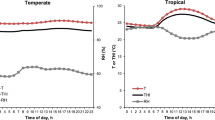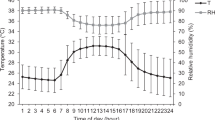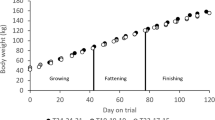Abstract
The objective of this study was to evaluate the performance and thermoregulatory responses during acclimation to high ambient temperature (Ta) of pigs from two lines selected for high (RFI+) or low (RFI−) residual feed intake with the hypothesis that RFI− pigs producing less heat would better tolerate high Ta. Pigs (50 kg initial body weight; 17 per line among which 10 of them were catheterized) were individually housed in a climatic-controlled room where Ta was maintained at 24.2 ± 0.4 °C during 7 days and thereafter at 30.4 ± 0.7 °C during 14 days. Irrespective of Ta, RFI− pigs had lower feed intake (ADFI) and similar average daily gain (ADG) than RFI+ pigs. Whatever the line, ADFI, ADG, and feed efficiency decreased with increased Ta. Overall, the Ta increase resulted in an increase in rectal temperature (RT), skin temperature (ST), and respiratory rate (RR) within the first 24–48 h and, subsequently, in a decrease followed by stabilization. The RT decrease during acclimation occurred 24 h earlier in RFI− pigs than in RFI+. Thyroid hormones and cortisol decreased at high Ta and it was similar in both lines. Based on performance and RT, ST, and RR responses, it seems that selection for low RFI tends to ameliorate pigs’ tolerance to high Ta. Nevertheless, this selection does not induce significant differences between lines in endocrine and metabolite responses during thermal stress.



Similar content being viewed by others
References
AOAC (1990) Official methods of analysis, 15th edn. Association of Official Analytical Chemists, Washington, DC
Barea R, Dubois S, Gilbert H et al (2010) Energy utilization in pigs selected for high and low residual feed intake. J Anim Sci 88(6):2062–2072
Becker BA, Knight CD, Veenhuizen JJ et al (1993) Performance, carcass composition, and blood hormones and metabolites of finishing pigs treated with porcine somatotropin in hot and cold environments. J Anim Sci 71(9):2375–2387
Bernabucci U, Lacetera N, Baumgard LH et al (2010) Metabolic and hormonal acclimation to heat stress in domesticated ruminants. Animal 4(7):1167–1183
Bianca W (1959) Acclimatization of calves to hot dry environement. J Agric Sci 52:296–304
Brown-Brandl TM, Nienaber JA, Xin H, Gates RS (2003) A literature review of swine heat and moisture production. Swine Housing II Proceedings. Amer Soc Agr Engineers, North Carolina, pp 031–040
Cai W, Casey DS, Dekkers JC (2008) Selection response and genetic parameters for residual feed intake in Yorkshire swine. J Anim Sci 86(2):287–298
Collin A, Vaz MJ, Le Dividich J (2002) Effects of high temperature on body temperature and hormonal adjustments in piglets. Reprod Nutr Dev 42(1):45–53
Crandall CG, Wilson TE, Marving J et al (2008) Effects of passive heating on central blood volume and ventricular dimensions in humans. J Physiol 586(1):293–301
Curtis SE (1983) Environmental management in animal agriculture. Iowa State University Press, Ames
D’Allaire S, DeRoth L (1986) Physiological responses to treadmill exercise and ambient temperature in normal and malignant hyperthermia susceptible pigs. Can J Vet Res 50(1):78–83
Florini JR, Ewton DZ, Coolican SA (1996) Growth hormone and the insulin-like growth factor system in myogenesis. Endocr Rev 17(5):481–517
Gaughan J, Lacetera N, Valtorta S et al (2009) Response of domestic animals to climate challenges. In: Ebi KL, Burton I, McGregor G (eds) Biometeorology for adaptation to climate variability and change, vol 1. Springer, Heidelberg, pp 131–170
Gilbert H, Bidanel JP, Gruand J et al (2007) Genetic parameters for residual feed intake in growing pigs, with emphasis on genetic relationships with carcass and meat quality traits. J Anim Sci 85(12):3182–3188
Gilbert H, Bidanel JP, Billon Y et al (2012a) Correlated responses in sow appetite, residual feed intake, body composition, and reproduction after divergent selection for residual feed intake in the growing pig. J Anim Sci 90(4):1097–1108
Gilbert H, Billon Y, Fleury J et al (2012b) Are responses to selection in lines divergently selected for residual feed intake in growing pigs affected by GxE interactions when bred in a tropical environment? Proceedings of the AnGR-NordicNET Workshop, Tuusula, Finland, pp 26–27
Giles LR, Black JL, Gooden JM, Annison EF (1991) Energy expenditure of growing pigs maintained at high ambient temperature. In: Batterham ES (ed) Manipulating pig production. Australian Pig Science Association, Albury, pp 52–55
Heo J, Kattesh HG, Roberts MP et al (2005) Hepatic corticosteroid-binding globulin (CBG) messenger RNA expression and plasma CBG concentrations in young pigs in response to heat and social stress. J Anim Sci 83(1):208–215
Herd RM, Bishop SC (2000) Genetic variation in residual feed intake and its association with other production traits in British Hereford cattle. Livest Prod Sci 63(2):111–119
Hoque MA, Suzuki K (2009) Genetics of residual feed intake in cattle and pigs: a review. Asian-Aust J Anim Sci 22(5):747–755
Horowitz M, Meiri U (1993) Central and peripheral contributions to control of heart rate during heat acclimation. Pflugers Arch 422(4):386–392
Huynh TT, Aarnink AJ, Verstegen MW et al (2005) Effects of increasing temperatures on physiological changes in pigs at different relative humidities. J Anim Sci 83(6):1385–1396
Kiefer C, Meignen BCG, Sanches JF, Carrijo EAS (2009) Response of growing swine maintained in different thermal environments. Arch Zootec 58(221):55–64
Kim BG, Lindemann MD, Cromwell GL (2009) The effects of dietary chromium (III) picolinate on growth performance, blood measurements, and respiratory rate in pigs kept in high and low ambient temperature. J Anim Sci 87(5):1695–1704
Le Bellego L, van Milgen J, Noblet J (2002) Effect of high temperature and low-protein diets on the performance of growing-finishing pigs. J Anim Sci 80(3):691–701
Le Naou T, Le Floc’h N, Louveau I et al (2012) Metabolic changes and tissue responses to selection on residual feed intake in growing pigs. J Anim Sci 90(13):4771–4780
Lefaucheur L, Lebret B, Ecolan P et al (2011) Muscle characteristics and meat quality traits are affected by divergent selection on residual feed intake in pigs. J Anim Sci 89(4):996–1010
Li G, Ali IS, Currie RW (2006) Insulin induces myocardial protection and Hsp70 localization to plasma membranes in rat hearts. Am J Physiol Heart Circ Physiol 291(4):H1709–H1721
Louveau I, Bonneau M (1996) Effect of a growth hormone infusion on plasma insulin-like growth factor-I in Meishan and Large White pigs. Reprod Nutr Dev 36(3):301–310
Luiting P, Schrama JW, van der Hel W, Urff EM (1991) Metabolic differences between White Leghorns selected for high and low residual food consumption. Br Poult Sci 32(4):763–782
Macari M, Zuim SM, Secato ER, Guerreiro JR (1986) Effects of ambient temperature and thyroid hormones on food intake by pigs. Physiol Behav 36(6):1035–1039
Marple DN, Aberle ED, Forrest JC et al (1972) Effects of humidity and temperature on porcine plasma adrenal corticoids, ACTH and growth hormone levels. J Anim Sci 34(5):809–812
Melchior D, Sève B, Le Floc’h N (2004) Chronic lung inflammation affects plasma amino acid concentrations in pigs. J Anim Sci 82(4):1091–1099
Nienaber JA, Hahn GL, Eigenberg RA (1999) Quantifying livestock responses for heat stress management: a review. Int J Biometeorol 42(4):183–188
Noblet J, Karege C, Dubois S, van Milgen J (1999) Metabolic utilization of energy and maintenance requirements in growing pigs: effects of sex and genotype. J Anim Sci 77(5):1208–1216
Pearce SC, Gabler NK, Ross JW et al (2013) The effects of heat stress and plane of nutrition on metabolism in growing pigs. J Anim Sci 91(5):2108–2118
Quiniou N, Dubois S, Noblet J (2000) Voluntary feed intake and feeding behaviour of group-housed growing pigs are affected by ambient temperature and body weight. Livest Prod Sci 63(3):245–253
Quiniou N, Noblet J, van Milgen J, Dubois S (2001) Modelling heat production and energy balance in group-housed growing pigs exposed to low or high ambient temperatures. Br J Nutr 85(1):97–106
Renaudeau D, Huc E, Noblet J (2007) Acclimation to high ambient temperature in Large White and Caribbean Creole growing pigs. J Anim Sci 85(3):779–790
Renaudeau D, Kerdoncuff M, Anais C, Gourdine JL (2008) Effect of temperature level on thermal acclimation in Large White growing pigs. Animal 2(11):1619–1626
Renaudeau D, Anais C, Tel L, Gourdine JL (2010) Effect of temperature on thermal acclimation in growing pigs estimated using a nonlinear function. J Anim Sci 88(11):3715–3724
Renaudeau D, Gourdine JL, St-Pierre NR (2011) Meta-analysis of the effects of high ambient temperature on growth performance of growing-finishing pigs. J Anim Sci 89(7):2220–2230
Renaudeau D, Collin A, Yahav S et al (2012) Adaptation to hot climate and strategies to alleviate heat stress in livestock production. Animal 6(5):707–728
Renaudeau D, Frances G, Dubois S et al (2013) Effect of thermal heat stress on energy utilization in two lines of pigs divergently selected for residual feed intake. J Anim Sci 91(3):1162–1175
Rhoads RP, Baumgard LH, Suagee JK (2013) Metabolic priorities during heat stress with an emphasis on skeletal muscle. J Anim Sci 91(6):2492–2503
Robbins KR, Saxton AM, Southern LL (2006) Estimation of nutrient requirements using broken-line regression analysis. J Anim Sci 84(suppl):E155–E165
Sauvant D, Perez JM, Tran G (2002) Tables de composition et de valeur nutritive des matières premières destinées aux animaux d’élevage. INRA, Versailles
Tavares SLS, Oliveira RFM, Donzele JL, Ferreira AS (1999) Influence of the environmental temperature on the performance and on the physiological parameters of female piglets from 30 to 60 kg. R Bras Zootec 28(4):791–798
Titto CG, Negrão JA, Titto EA et al (2012) Effects of an evaporative cooling system on plasma cortisol, IGF-I, and milk production in dairy cows in a tropical environment. Int J Biometeorol 57(2):299–306
Van Soest PJ, Wine RH (1967) Use of detergents in the analysis of fibrous feeds. IV. Determination of plant cell-wall constituents. J Assoc Off Anal Chem 50:50–55
Acknowledgments
The authors gratefully acknowledge Loïc Gaillard, Francis Le Gouevec, Alain Chauvin, Régis Janvier, Serge Dubois, and the GENESI staff for animal care and technical assistance. Aline Foury, Laure Gress, Anne Pasquier, and Christine Tréfeu for the laboratory analysis. Bruno Silva is thanked for the critical evaluation of the study. This experiment was supported by the French National Research Agency (ANR), program “PIG_FEED” (ANR-08-GENM-038). Financial support from CAPES (Coordenação de Aperfeiçoamento de Pessoal de Nível Superior) and CNPq (Conselho Nacional de Desenvolvimento Científico e Tecnológico) is also acknowledged.
Author information
Authors and Affiliations
Corresponding author
Rights and permissions
About this article
Cite this article
Campos, P.H.R.F., Noblet, J., Jaguelin-Peyraud, Y. et al. Thermoregulatory responses during thermal acclimation in pigs divergently selected for residual feed intake. Int J Biometeorol 58, 1545–1557 (2014). https://doi.org/10.1007/s00484-013-0759-3
Received:
Revised:
Accepted:
Published:
Issue Date:
DOI: https://doi.org/10.1007/s00484-013-0759-3




